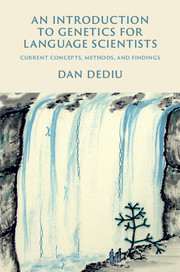Book contents
- Frontmatter
- Dedication
- Contents
- List of illustrations
- Acknowledgements
- 1 Introduction
- 2 Nature, nurture, and heritability
- 3 The molecular bases of genetics
- 4 Effects of genes on phenotype
- 5 Linkage disequilibrium and its role in finding genes
- 6 What do genes actually do?
- 7 The way forward: exome and genome sequencing
- 8 Population and evolutionary genetics
- 9 Interactions between genetic and cultural evolution
- 10 Conclusions, topics not covered, future directions
- Appendix The computer code
- References
- Index
- Glossary
4 - Effects of genes on phenotype
Published online by Cambridge University Press: 05 April 2015
- Frontmatter
- Dedication
- Contents
- List of illustrations
- Acknowledgements
- 1 Introduction
- 2 Nature, nurture, and heritability
- 3 The molecular bases of genetics
- 4 Effects of genes on phenotype
- 5 Linkage disequilibrium and its role in finding genes
- 6 What do genes actually do?
- 7 The way forward: exome and genome sequencing
- 8 Population and evolutionary genetics
- 9 Interactions between genetic and cultural evolution
- 10 Conclusions, topics not covered, future directions
- Appendix The computer code
- References
- Index
- Glossary
Summary
Here we encounter the patterns of transmission of genes across generations and the main types of effects they can have on the phenotype. We will discuss autosomal versus sex-linked loci, exemplified using the dominant speech and language pathology apparent in members of the famous British KE family (and due to a mutation in FOXP2, a gene that we will encounter again later in the book), a very interesting case of recessive transmission of hearing loss that ultimately resulted in the emergence of a new sign language in a village on the island of Bali, and, finally, the fascinating transmission of deficits in colour perception (which might turn out to affect language). We will introduce here some concepts of classical genetics and basics of statistical testing (such as the χ2 test).
In diploid organisms, such as ourselves, the vast majority of genetic loci have two alleles, as discussed above. For example, the two loci in Figure 3.8 part (i) in the parent (left) have alleles A and a at the first locus, and B and b at the second, but there are also many loci at which the two alleles are identical. To use a real example studied by William Bateson, Edith Saunders and Reginald Punnett at the beginning of the 20th century (Bateson et al., 1905; Lobo and Shaw, 2008), let's for a moment look not at a human but at a sweet pea (Lathyrus odoratus), and more precisely at a locus that influences the flower's colour, with allele A resulting in purple flowers while allele a results in red flowers.
Dominance and recessiveness
But how can we talk about the effects of a single allele, such as A, in diploid organisms? We can look at homozygous individuals that happen to have two copies of the same allele at this locus and observe that AA individuals produce purple flowers while aa ones have red flowers. But what happens to heterozygous individuals that have different alleles at the same locus? In this particular case, the heterozygous Aa individuals (the order in which the alleles are written, Aa or aA, is irrelevant here) produce purple flowers, just like the homozygous AA individuals.
- Type
- Chapter
- Information
- An Introduction to Genetics for Language ScientistsCurrent Concepts, Methods, and Findings, pp. 72 - 89Publisher: Cambridge University PressPrint publication year: 2015



